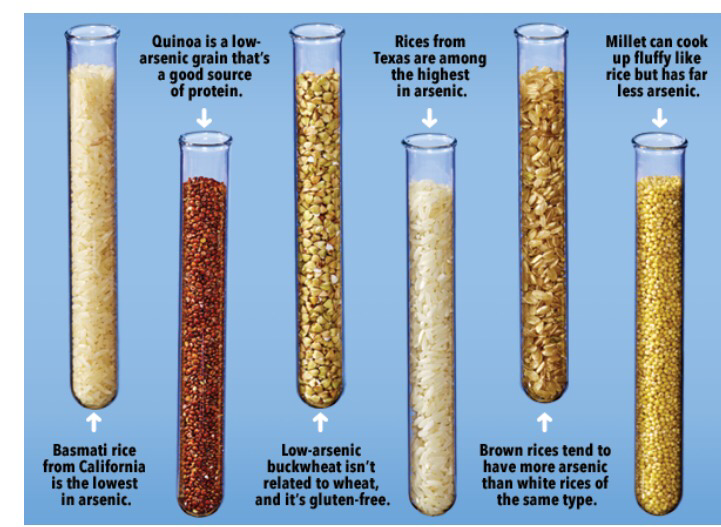
Based on the conference notes presented by Dr. Joel Foreman as mentioned in a previous post Medical Evidence on Organic vs Non-Organic Foods, I will discuss Arsenic today. The effects on human health and ways you can reduce your exposer.
- Arsenic is in pesticides applied to cotton and orchards since 1940
- It comes in two chemical forms organic and inorganic. The inorganic form of arsenic is cancer causing.
- Organic fields that no longer use pesticides and herbicides, still have high levels of arsenic in the soil and water from previous pesticide/ herbicide use.
- It is put in chicken feed which is then excreted in chicken waste that is then used as fertilizer and cattle feed (arsenic is used as a growth promoter, color enhancer, and disease preventer in chicken)
- Pressure treated wood used in residential housing (banned in 2003)
- Paints and dyes.
- Contaminated waste, herbicides, and pesticides leak into the soil which then leak into the water source, and this leads to contaminated drinking water
- Contaminated soil leads to contaminated grain
- Contaminated water and soil result in arsenic containing rice
In Chile and Bangladesh Arsenic contaminated water (from deep wells) was introduced into the city water supply to address the issue of chronic diarrheal disease. A large study in 2006 found that chronic exposure to Arsenic in these populations led to skin changes, skin nodules, skin cancer, lung and bladder cancer, problems with neurological and behavioral development, chronic lung disease such as bronchiectasis, and Type 2 diabetes. These findings were most obvious in fetuses and young children.
How do we decrease our exposure to Arsenic?
In 2006 water standards were created for wells and city water. In most states, safe levels of inorganic arsenic in the water supply should be less then 10 parts per billion (ppb) Get the chart to learn when you need to test your well water: Well Water Testing Recommendations from the AAP

Arsenic is in Rice.
Rice is a grain that is grown in water and has a tendency to absorb arsenic very easily. Consumer reports has done an in depth analysis of arsenic levels in rice. Consumer Reports – Arsenic in Rice

Rule – no more than 7 points per week

Article was published in the January 2015 Consume Reports.
- No rice cereal for babies. None.
- Fruits and veggies should be the first foods for babies.
- Use oatmeal cereal as thickener for baby foods if needed.
- Avoid baby formulas, toddler formulas, and toddler snacks with brown rice syrup.
- Do not use rice milk as an alternative to dairy. Unsweetened almond milk is a great alternate choice.
- Read labels and avoid rice syrup sweeteners
- Beware that gluten free products have various processed rice additives such as rice flour, rice syrup, etc.
- Use a variety of grains such as Quinoa, Bulgur, and Millet.
- Review the chart above as a guide for rice consumption
- Change the way you cook rice. Traditionally, people rinse rice then cook it in sufficient water that is absorbed during simmering. Rinsing rice removes only a small amount of arsenic, but it removes most of the nutrients in rice. Do not rinse Cook rice like pasta. Put rice in a ton of water, cook it to your liking, then strain the extra water out like pasta. This removes the majority of the arsenic, but little of the nutrients.
- Organic rice has the same amount of arsenic as non-organic rice. Remember that the soil and water contamination is the problem even when pesticides and herbicides are no longer used.
Lastly, due to the pesticides and herbicides used on orchards and vineyards, apples and grapes juice have high level of arsenic.

- The fruits themselves contain low levels of this chemical.
- When many fruits, especially fruits imported from other countries, get juiced and boiled together, it leads to concentrated levels of arsenic.
- Juice consumption in children is much higher then recommended. Pediatricians generally hate juice, but the AAP recommendations are 4-6oz a day. Majority of children drink 2-5 times this recommended amount.
- Urine studies in children drinking juice daily show levels of arsenic above the 10 ppm, which we discussed as the recommends safe threshold in drinking water
- The FDA has not made any recommendations for safe levels in apple and grape juice at this time.
- Consumer Reports – arsenic in juice
- When the FDA looked at levels or arsenic in juice, they focused on 4-6oz of juice, which as I discussed is WAAAYYYY less then what most kids drink daily.
Once again Great info, but what do we do?
- stop buying apple and grape juice
- make juice at home from locally grown and organic apples and grapes
- no daily juice in daycares and preschools. Speak with the schools. NYC has already passed a law prohibiting this. If enough parents speak up, the day cares will stop. Juice is cheap, milk is not. Hey, water is free.
- no daily juice for babies and toddlers
- Water and Milk, People!! Water and Milk. An occasional juice here and there is no big deal and keep it to 4-6oz. Can we just stop with the juice already!!!
- no juice boxes in kids lunches
- apples have tremendous health impact and should be part of the daily diet. Grapes have amazing health benefits and should be eaten regularly. Eat the fruit, not the store bought juice.In Good Health, Ana-Maria




